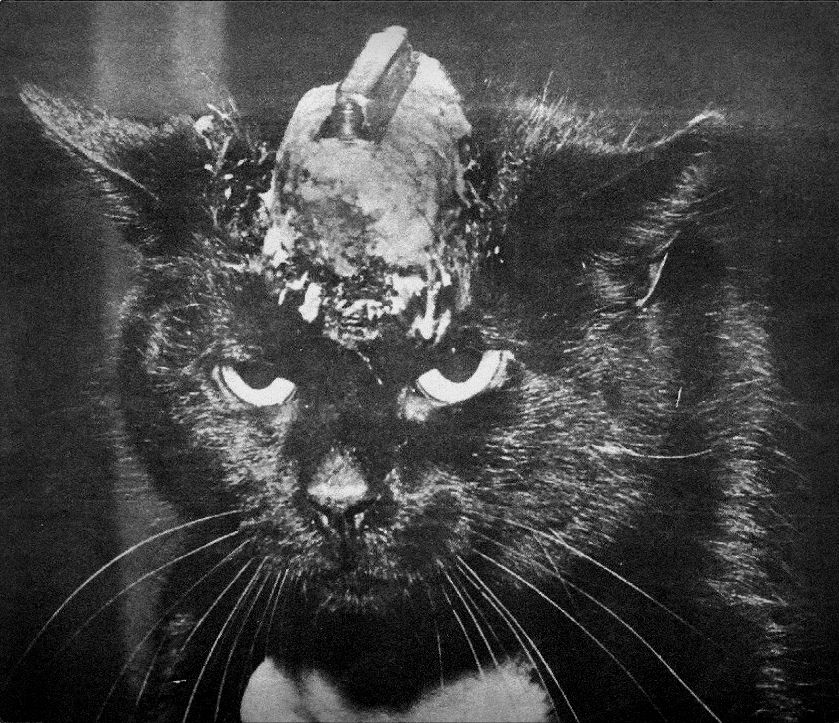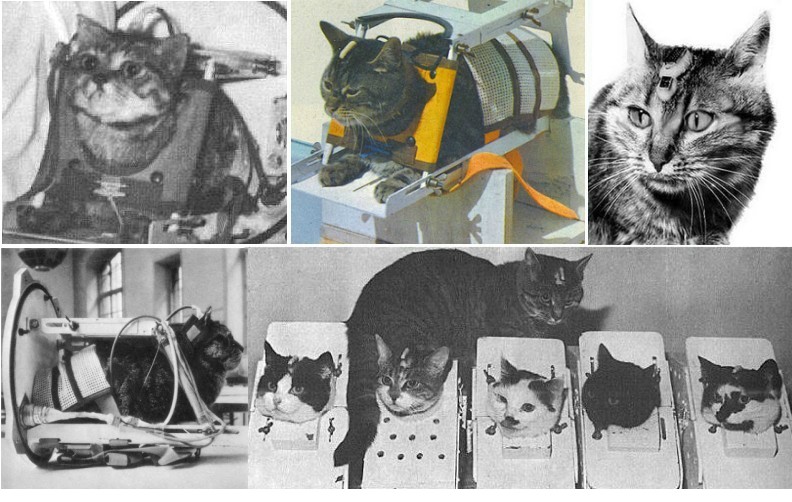
CATS IN BIONICS, BIOTECHNOLOGY, SPACE AND SPYING
It's a sad fact of life that thousands of cats are used in scientific experimentation, undergoing invasive procedures that most often do not benefit the unfortunate creatures involved and that frequently cost them their lives (those that survive experiments generally being destroyed afterwards). I personally do not support experimentation on animals as they are unable to give consent, nor can they understand what is being done to them.
Oscar the bionic cat, with his prosthetic hind legs, is an exception. Although this was a pioneering operation, it has enabled Oscar to live a normal life as well as providing information that is helping human amputees. The French astronaut cats and the CIA's acoustic cats were less lucky.
OSCAR THE BIONIC CAT
In 2009, two year old Jersey cat Oscar suffered a horrific accident when his back paws were sliced off by a combine harvester. His owner, Michael Nolan, expected Oscar to be put to sleep. While cats generally adapt well to a three-legged lifestyle, very few have adapted to walking on 2 legs, most having been born that way. Their independence and default indoor-outdoor lifestyle mean they may not adapt to using "mobility carts" or "animal wheelchairs" (e.g. K9 Karts).
Oscar is believed to be the first cat in the world to have been fitted with new feet. After recovering from the accident, he was fitted with prosthetics by pioneering veterinary neuro-orthopaedic surgeon Noel Fitzpatrick. In 2008, Fitzpatrick had made an artificial knee for a cat, Missy, injured by a hit and run driver.
During a three hour operation, Fitzpatrick carefully drilled into Oscar's narrow ankle bones on both back legs before sliding two metal rods into the holes. These cutting edge implants, called Intraosteous Transcutaneous Amputation Prosthesis (ITAP) were developed in 2006 by Professor Gordon Blunn and his team at University College London. Unlike a conventional prosthetic that straps to the stump, an ITAP attaches to the bone at the point of amputation and sticks out of the skin. Once the patient has healed, the prosthetic limbs are simply screwed on to the external bit of the ITAP.
An ITAP is based on the way a deer’s skin and fur moulds around antlers. It is a titanium metal implant (a rod and flange) which attaches to the bone at the point of amputation and protrudes through the skin. Usually, attaching metal to skin and bone leaves the patient susceptible to infection (a risk when external fixators are used to stabilise fractures) but the new method enables bone, skin and soft tissue to mesh and grow around the metal rod to form a protective seal. Once the bone and skin have grown into the implant it forms a "exoprosthesis" that allows this implant to work as a see-saw on the bottom of the limbs and provide an almost normal gait. This flexibility means the implant acts more like part of the bone rather than like an attachment.
Once Oscar had healed he had his first prosthetic paws attached; these were temporary paws made of rubber and Oscar quickly learnt to walk on them and rebgain strength and mobility in his hindlimbs. He was later given cutting edge "blade runner" style paws made of rubber and metal (similar to those used by paralympian athletes), which will help him run, jump and climb with greater ease. Oscar spent four months in rehabilitation, learning how to walk properly on his prostheses and having his progress monitored for any sign of soreness, infection or rejection around the implant.
Oscar's prosthetic paws were specially made with a degree of wobble to mimic normal paws, however, he will now have to be a house cat because the false limbs are not suitable for his previous indoor-outdoor lifestyle. While the prosthetic limbs may not last forever, Oscar can expect a number of years of pain-free and fully mobile life. Four pairs of longer lasting prosthetic paws had to be made because active Oscar wore through his first set in weeks!
According to Dr Mark Johnston, a spokesman for the British Small Animal Veterinary Association, Oscar is a lucky cat. "Giving a cat artificial limbs is a very novel solution." Johnston noted that cats don't usually adapt to a wheelchair because of their freer lifestyle, "If a cat has two legs that are damaged beyond repair, it's very hard to keep him going. We would generally euthanize a cat in that situation." It's also unlikely the technique will be widely available for pets due to the cost and expertise required - the prosthetics cost about £2,000 pounds ($3,000) to make, not including the cost of surgery.
Noel Fitzpatrick will only perform such surgeries if the outcome has a good chance of improving an animal’s quality of life. While some people protest that it is a huge amount of money, effort and time to spend on a pet that has a relatively short life-span (compared to humans) and that should be cheaper to replace, the technology will also provide benefits for humans in the long term. It offers hope to amputees and to those born with missing limbs.
THE PNEUMATIC MAIL CAT
In 1897, a $4 million system of pneumatic mail tubes was launched in New York City. The pneumatic tubes were installed a few feet below the sidewalks (pavements) and fired almost 100,000 letters each day at a speed of around 35 mph. It was propelled by pressurized air. This underground network extended from Brooklyn's General Post Office to Harlem to Times Square and Grand Central Terminal and was extremely efficient, especially in hard winters when the streets above were almost impassable. The pneumatic mail system continued until 1953 before becoming too costly to run.
The "rocketeers" that operated the New York mail tubes launched a maiden capsule containing a black cat on October 7th, 1897. This was witnessed, and documented, by post office worker Howard Wallace Connelly. Over one hundred excited Post Office officials watched and waited for the first canisters to arrive. The first one contained an artificial peach and was brought out which was followed one minute later by the second canister which contained a live black cat sent from Manhattan's Produce Exchange Building to Brooklyn. This was apparently a prank, but it also demonstrated the safety of the sytem for delivery of fragile packages.
After its no doubt frightening journey, the cat appeared stunned. Connelly wrote, "How it could live after being shot at terrific speed from Station P in the Produce Exchange Building, making several turns before reaching Broadway and Park Row, I cannot conceive, but it did. It seemed to be dazed for a minute or two but started to run and was quickly secured and placed in a basket that had been provided for that purpose." Whether it was returned home the same way is not recorded.
This feline test pilot was not the only animal to be sent through the pneumatic mail, nor was it the only cat. Later on, a sick cat was sent to an animal hospital in a pneumatic tube. The ailing animal apparently, "leaped from the open container and put up quite an effort before finally being captured."
CATS IN SPACE - FELIX AND FELICETTE
In the late 1950s and early 1960s, the Russians sent dogs into space and the Americans used chimpanzees. The French were the only ones to use cats. In the early 1960s, the French government obtained numerous cats and subjected them to initial tests for suitability as space-flight subjects. The cats were conditioned to live in small and enclosed spaces - in other words strapped into boxes with only their heads exposed. They had electrodes implanted into their brains to measure neural impulses. The cats were suited in special spacesuits which monitored their vital signs and were subjugated to a battery of tests intended to simulate launch and reentry conditions. These would have included rather painful periods in compression chambers, centrifuges and rocket propelled sleds. Of the original ten cats, some appear to have been too feisty, while others apparently ate too much (no doubt from boredom while being confined), making them unsuitable for the mission.

France planned to launch a tabby male cat called Felix into space on October 18, 1963. Felix was apparently a Parisian stray cat, though the official written report says the cats were bought by the French Government from dealers, they probably came from an animal shelter. According to legend, on the day of the launch, Felix (living up to his name, which means "luck") managed to escape and his replacement was a black-and-white female cat called Félicette. In fact there was no Felix, and Felicette was launched on 18 October 1963 on the French Véronique AG1 rocket launched from Bacar rocket base at Hammaguir in the Algerian Sahara desert. Felicette did not go into orbit, but spent 15 minutes in sub-orbital flight, reaching the altitude of 130 miles. Her space capsule separated from the rocket and descended by parachute. Felicette returned to Earth alive and was safely recovered. Throughout the flight and descent, the electrodes implanted in her brain transmitted neurological impulses back to Earth. Later on, the French Centre d'Enseignement et de Recherches de Médecine Aéronautique (CERMA) (Centre for Education & Research into Aerospace Medicine), which directed these flights, stated that the cat had made a valuable contribution to research. Several months later, Felicette was killed in order to study the electrodes in her brain. She was reported in the British press as "Astrocat".
|
|
|
|
On 24 October, 1963, the French sent another (un-named) cat into space. The capsule containing this unfortunate creature was recovered two days late, by which time the ill-fated cat had died.
Félix and Félicette have been commemorated on postage stamps in France and French territories. Prior to the launch, there were publicity photos of tabby cat Felix, hence it is his image that often appears on stamps even though he escaped prior to the space flight. After ther space flight, a publicity photo was released of Felicette featuring a pawprint and the caption "Merci pour votre participation à mon succès du 18 octobre 1963" (Thank you for your part in my success of 18 October 1963).
OPERATION ACOUSTIC KITTY
At the height of the Cold War, the US Central Intelligence Agency was willing to try just about anything to gain an advantage over the dreaded Communists. In the early 2000s, documents from the CIA’s Directorate of Science and Technology were requested under the Freedom of Information Act by Jeffrey Richelson, a senior fellow at the national security archive in Washington. Alongside other bizarre ideas, these reveal the CIA's attempts to implant bugging devices into cats that would then eavesdrop on Soviet conversations from park benches, windowsills and dustbins. Cats were selected because, like humans, their cochlear anatomy allows them to filter and focus sound. The cat was meant to stroll up to the sensitive conversations without attracting notice, and its internal bugging equipment would overhear and relay the audio to agents in a nearby vehicle.
During this era, the CIA's animal (and human) experiments were unregulated. A CIA memo dated 1967 on "Views of Trained Cats" details the possibility of surgically inserting microphones and transmitters into cats and using them as walking bugs. The operation was codenamed "Acoustic Kitty" and had begun in 1961. According to former CIA officer Victor Marchetti, "They slit the cat open, put batteries in him, wired him up. The tail was used as an antenna. They made a monstrosity. They tested him and tested him. They found he would walk off the job when he got hungry, so they put another wire in to override that. Finally, they’re ready. They took it out to a park bench and said, 'Listen to those two guys. Don’t listen to anything else – not the birds, no cat or dog – just those two guys!' "
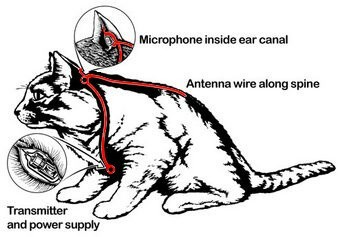
Marchetti recalls, "The cat that was used for the experiments had to be cut open and have a power pack placed inside its abdomen, wires were run up to its ears, to its cochlea, its tail was used as an antenna, wires were hooked to its brain to determine when it was hungry or sexually aroused, and wires to override these urges" so the cat wouldn’t walk off the job." Former CIA technical officer Robert Wallace added to the information: "the implant could not affect any of the natural movements of the cat, nor could the cat experience any sense of irritation or the presence of the device, lest it induce rubbing or clawing to dislodge components or disturb performance."
Thus the poor creature was wired to innocuously record and transmit sound from its surroundings and trained to listen specifically to human conversation. Surgical and intensive training is believed to have cost $15-20 million over 5 years. On the cat's first field test, the CIA drove to a Soviet compound on Wisconsin Avenue in Washington, DC, and let it out of a parked van across the street. The cat walked into the road where it was almost immediately struck and killed by a taxi (probably a merciful end for this mutilated creature). Again in Marchetti's words "They took it out to a park and put him out of the van, and a taxi comes and runs him over. There they were, sitting in the van with all those dials, and the cat was dead." And in more of Marchetti's words, "as this poor little monstrosity waddled across the street, a taxicab came around and ran it over, 25 million dollars down the drain."
A CIA operative recovered the cat’s remains to prevent the Soviets from discovering the sensitive and expensive listening devices in its body. Dr Richelson, of the National Security Archive in Washington, commented "I'm not sure for how long after the operation the cat would have survived even if it hadn't been run over."
I haven't found details of how many cats did not survive surgery, training or missions in the field, but evidently a number of cats were implanted with electronic devices. Operation Acoustic Kitty was completely abandoned in 1967 after the failure of "subsequent tests". The experiment was declared a complete failure.
Possibly due to their embarrassing nature, the documents describing Acoustic Kitty remain partially censored, however, one of the released documents does praise the Acoustic Kitty team for its efforts: "The work done on this problem over the years reflects great credit on the personnel who guided it, particularly (names censored), whose energy and imagination could be models for scientific pioneers." The memo concludes that while the use of trained cats was possible, and that researchers could train cats to move short distances, “the environmental and security factors in using this technique in a real foreign situation force us to conclude that for our (intelligence) purposes, it would not be practical," or, according to Robert Wallace, "the cat wanted to do what the cat wanted to do, and not what we wanted it to do."
Fernand Mery reported an experiment by Dr Jose Delgardo and neurophysiologists at Yale University that took place in the early or mid 1960s. Delgardo installed a series of electrodes in the brain of a cat. Once the surgical site had completely healed, experiments began. Experimenters reported that the cat made no attempt to escape and even seemed to appreciate the attention he got. He behaved as if he were obeying a simple, friendly drill in a robot-like manner.A reciever was set on a small collar and silver wires, each corresponding to a cerebral location, disappeared under the fur and through the skin. Radio-transmitted commands prompted the cat to eat or drink, to eat or even to scratch. Bu stimulating part of the frontal lobes, the cat could be provoked to aggression or affection, and those states could be also be cancelled immediately. Were these the predecessors of the acoustic kitty?
By coincidence, in 1966 - the same year that Acoustic Kitty was tested - a British film called "Spy With a Cold Nose" featured a dog wired up to eavesdrop on the Russians.
These days, transmitters capsules are sometimes implanted into the abdomens of big cats that are rehabilitated and released back to the wild. Less of a hindrance than old-fashioned radio-tracking collars, the internal transmitters allow the animal to be tracked across its range so it progress can be monitored.
BIOTECHNOLOGY CATS
Cc and Other Cat Clones
In February 2002, scientists in Texas announced the world's first "Copy Cat" - a cloned kitten named Cc (who was nicknamed "Copycat" or "Identicat" by the media) - that had been grown from a cell taken from an adult tortoiseshell-and-white (calico) female called Rainbow. The nucleus of this cell was inserted into an egg in a technique called "nuclear transfer". Mark Westhusin and his colleagues from the College of Veterinary Medicine at Texas A&M University fused a cell from one of the adult cat's ovaries with an egg from which the nucleus had been removed. Genetic material from the adult cell was transferred into the egg. This grew into an embryo and was implanted in a surrogate mother. Out of 188 attempts to create embryos, 87 cloned embryos were made and transferred into 8 surrogate mothers. Only two resulted in pregnancies and only one pregnancy was successful.
Cc was born by Caesarean section in December 2001. She was reported to be vigorous at birth and appeared to be completely normal. Despite being a clone, Cc's coat has a different pattern from that of the donor cat because the pattern of pigmentation in multi-coloured animals is not solely caused by the genes, but also by the way the cat develops i.e. what genes are switched on or off in each individual skin cell (though the cells may be identical, some have "black" switched on while others have "orange" switched on). Hence Copycat was a tabby-and-white cat, having been grown from a cell in which the orange gene had been switched off. Cc's disposition was also very different from that of her genetic mother. Temperament is controlled partly by genes and partly by environment, both inside the womb and during a cat's lifetime.
Cc came from a cumulus cell - a type of ovarian cell that surrounds developing eggs and which is, therefore, found only in female animals. Other implanted embryos came from skin cells. In mice, male clones have been created from Sertoli cells which come from the testes. There will also be other DNA present because only the nucleus was transferred to the egg - other parts of the cell (the mitochondria) do not come from the clone donor cell, but from the egg cell.
Though this was a great step forwards, the failure rate for cloning is still extremely high - only 1 out of 87 attempts resulted in a clone - and the kitten was not born naturally. The donor cat may undergo repeated invasive procedures to extract cells while the surrogate mother must be induced to ovulate and then implanted with the clone embryo. This means repeated anaesthesias. On the day Cc was born, 6,000 unwanted pet cats and kittens were destroyed in the USA.
The success of Cc's birth has implications for conservation. India announced plans to clone cheetahs to help restore the Indian sub-continent's cheetah population (which was wiped out) using genetic material from Asiatic cheetahs in Iran. The Asiatic cheetah is now restricted to around 50 individuals in a few locations in Iran. Scientists at Hyberabad's Centre for Cellular and Molecular Biology are aware that it will not be hard to achieve. They plan to use an Indian leopard as surrogate mother to produce the cloned cheetah cubs. This means the offspring would have nuclear DNA from the cheetah cell and mitochondrial DNA from the surrogate's mother's egg cell.
In 2003, Martha Gomez's team at the Audubon Center for Research of Endangered Species (New Orleans, Louisiana, USA) cloned the African wild cat, using domestic cats as surrogate mothers. They were created using African wildcat nuclear DNA with domestic cats being used as egg donors and surrogate mothers. The next step is to demonstrate that the clones breed normally. The results were 2 males (a third male did not survive) and 5 females; these will now be bred in the conventional manner. African wildcats are very closely related to domestic cats.
In 2004 and 2005, Gomez's team attempted to clone the rare Black-Footed Cat (a southern African small cat) and hoped to clone the Rusty Spotted Cat (a small cat from India and Sri Lanka). Cloned Black-Footed Cat embryos, were implanted into a domestic cat surrogate mother, but none survived to full term. It is possible that the two species are too distantly related for the surrogacy to work. To clone the Rusty Spotted cat, preserved cells from a deceased US zoo specimen will be used. There are 13 rusty spotted cats in captivity and their wild counterparts are endangered by hybridisation with domestic cats.
In theory, an extinct species could be cloned if intact nuclear DNA can be extracted and implanted into the egg of a compatible living species. This is more feasible with a recently extinct species and would need cells from both males and females. The lack of undamaged DNA means species such as moas, dodos, warrahs, quaggas, thylacines and mammoths will remain extinct, at least for the foreseeable future.
Mr Green Genes and Other Bioluminescent Cats
British scientists at the Roslin Institute used a lentivirus to introduce the green fluorescent protein gene (GFP) from jellyfish into chickens and pigs, some of which produced green offspring, demonstrating the heritability of the introduced genetic material. Building on both transgenic and cloning technologies, in 2007, South Korean researchers cloned cats and modified one of their skin genes to fluoresce red under UV light. They used skin cells of a female Turkish Angora cat and modified its genes using a virus. The modified cells were inserted into feline ova which were implanted into the womb of the donor cat. Three kittens were born in January and February 2007 by caesarian section, but one died during the procedure. The two survivors grew to become adult Turkish Angoras, weighing 3kg and 3.5kg. Under UV light, the genetically modified kittens glow red while an ordinary kitten appears to be green.
In October 2008, researchers at the Audubon Centre for Research of Endangered Species in New Orleans announced "Mr Green Genes" a transgenic ginger tabby cat that glows green under UV light. His eyes, gums and tongue glow a vivid lime green. Mr Green Genes was the first fluorescent cat in the United States and contains the enhanced GFP gene from jellyfish. The researchers wanted to learn whether a gene for fluorescence could be introduced harmlessly into the feline genetic sequence. The next step is to breed him and see if the gene is inherited by his offspring. While Mr Green Genes may lead a normal life (away from UV lights), his less lucky descendents will eventually be destined for animal experimentation. This is part of an experiment that could lead to treatments for conditions like cystic fibrosis where cats are used because of their similarity to humans. The fluorescence gene will be inserted next to the cystic-fibrosis gene to make it easy to spot to see how things work inside animals and even inside cells.
In September 2011 Nature Methods journal reported that cats had been genetically modified to glow in the dark in order to gain insights into Aids through studying the feline immunodeficiency disease FIV (a virus similar to AIDS, but specific to cats). Scientists inserted a gene into the cats that helps them resist the feline form of Aids. They also inserted a marker gene that produces GFP in jellyfish, to monitor the activity of altered genes. This allowed them to identify cells carrying the anti-viral gene simply by shining a UV light on the animal or on cell samples under the microscope.
The antiviral gene was taken from a rhesus macaque, and it produces a protein called a restriction factor that can resist immunodeficiency viruses. This was transferred into feline oocytes (eggs) from ovaries harvested during normal spay surgery. The eggs were fertilised through IVF and implanted into female cats. Twenty-two attempts led to the birth of only five kittens of which only three survived. Two of the surviving kittens were healthy but the third suffered unrelated medical problems. Unlike previous green-glowing cats which caused the white areas of a cat's coat to glow green, these cats were tabbies and all of the tissues fluoresced; the claws and furless areas of the body being particularly noticeable.
Almost all offspring from these modified eggs had the restriction factor genes and because it had been introduced into the egg, the anti-viral protein (and the fluorsecing protein) was made throughout the cats' bodies. Both humans and cats already produce proteins called restriction factors to fight off viral infections, but these restriction proteins are defenceless against HIV (in humans) and FIV (in cats) because the viruses have evolved their own counter-weapons. However, some monkeys have evolved restriction factors capable of overcoming the viral counter-weapons. Two of the genetically modified cats went on to produce kittens of their own, all of which inherited the restriction factor and fluorescing genes.
Scientists tested cell cultures from the GM cats and found there was reduced replication of Feline Immunodeficiency Virus (sometimes called Feline AIDS). Like HIV, FIV wipes out infection-fighting T-cells. Sadly for the studied cats, the next step is to deliberately expose them to FIV and see if they are resistant. If they do have resistance, it may help in preventing FIV in the future and in combatting HIV in humans. While the introduction of genes from a monkey and from a jellyfish do not appear to have caused adverse side-effects, genes often work as "cascades" and turn each other on or off. There is a risk that introduced genes can interfere with the actions of normal feline genes so that other proteins might not be produced correctly resulting in health issues that are not immediately evident. While the cats appear physically well, critics question the mental welfare issues. Meanwhile, the possibility of green-glowing pet cats has piqued the interest of other people.
WARFARE CATS
Below is a 16th century design for a weapon. There are numerous variations on this image.
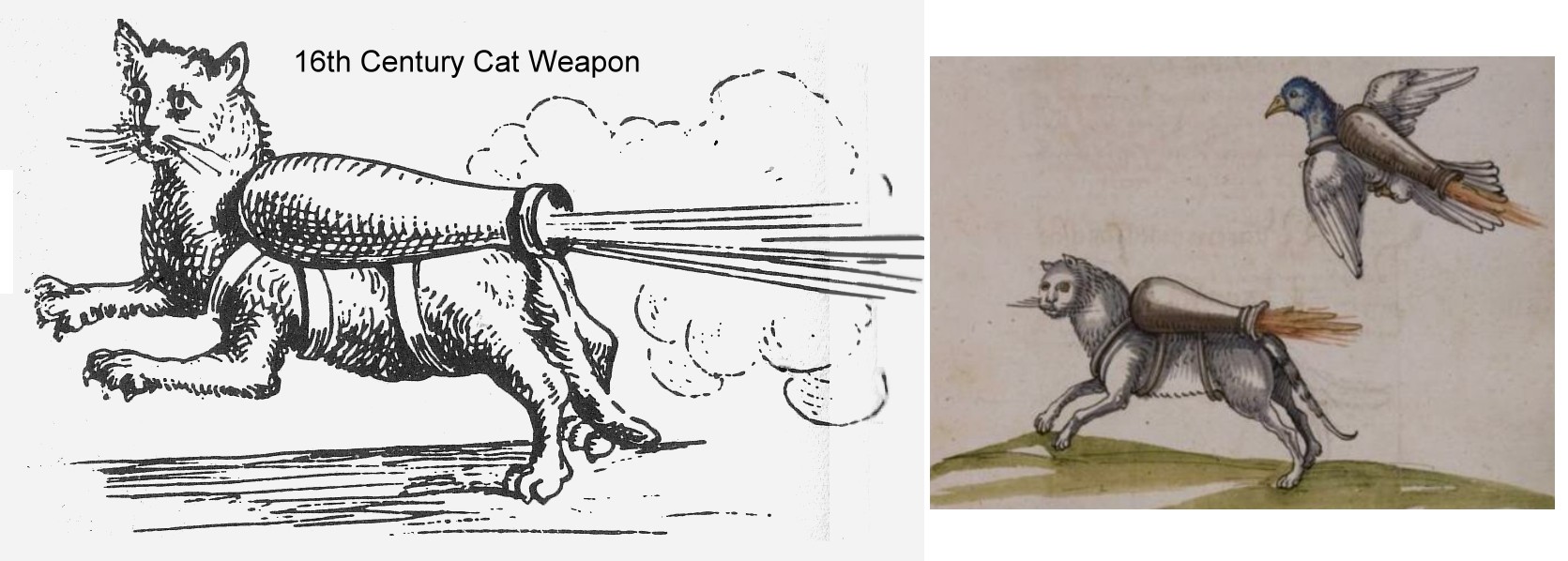
In the 16th century, cats and other pets were considered a way of bombing cities under siege. The idea was to put timed incendiary devices (i.e. using a slow fuse) onto captured cats and birds before releasing them to return to their homes inside the besieged city. The theory was that the cat, being unnerved by the fizzing incendiary, would bolt for home through gaps too small for human besiegers to get through (and in the case of birds, over the city walls or castle ramparts).
There are several illustrations of the "rocket cats" in a 1530s manuscript at the Universitätsbibliothek Heidelberg, in the 1584 Feuer Buech (Fire Book) manuscript housed at the University of Pennsylvania, where the illustration is entitled "To ignite a castle or city which you can’t otherwise get at, and in the Armamentarium principale oder Kriegsmunition und Artillerie-Buch (a. M Frankfurt, 1625). Readers of Helm's treatise are advised to "Make a small sack like a fire-arrow [...] if you would like to attack a town or castle, capture a cat from that place and bind the [fire] sack to the cat's back, ignite [the fuse], let it glow well and then let the cat go so that it runs to the nearby castle or town, and in its terror it runs to hide in a barn where the hay or straw it will catch fire." This suggests an arson attack, rather than an explosive device, not that the poor cat would be interested in debating the difference.
One of the authors, Franz Helm, (c1500-1567) wrote extensively on the manufacture and various uses of munitions in warfare (Buch von den probierten Künsten, Germany, 1535). Luckily, the rocket-cat suggestion does not appear to have been put into practice. From the Artillerie Buch (1625): “Mach ein klein secklein wie zu einem fewer pfeyl…tracht ob du mogest Bekhomen im schloss oder statt, ein katzen so darein gehörig, unnd bind das secklein der katzen auff den Rucke, zunde es an lass wol gluen, unnd darnach die katzen Lauffen, So tracht sie dennegsten, dem schloss oder statt zw, und vor forcht gedenckt sie sich zuuerfriechenn, wo sie in scheweren hew oder stroe findt, wurtt es von ir angezundet.”
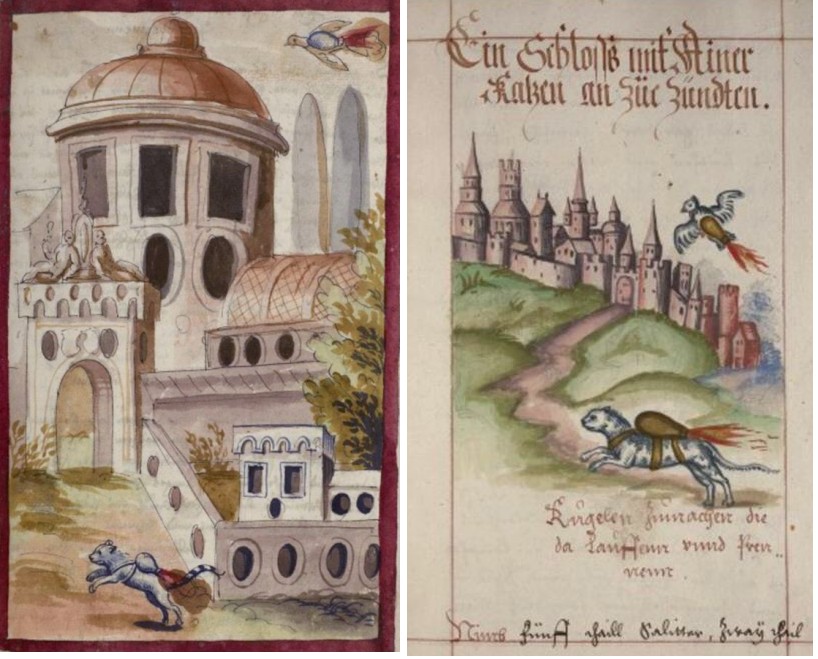
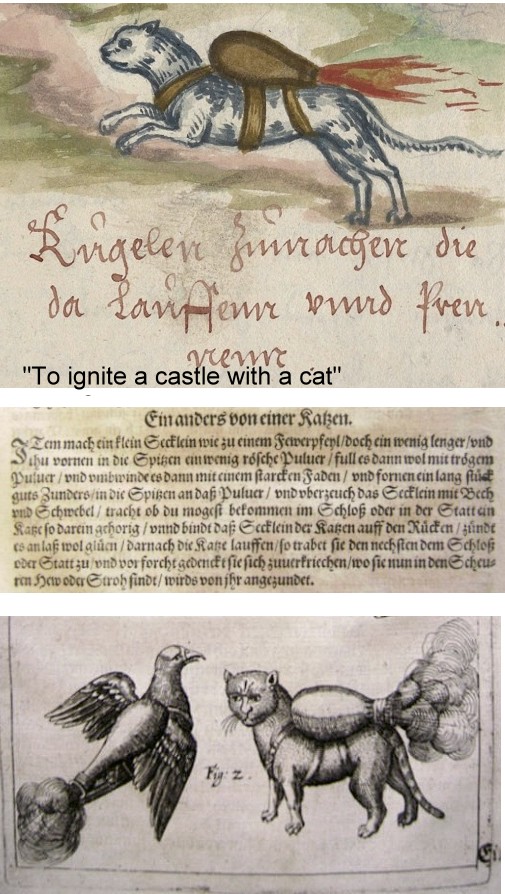
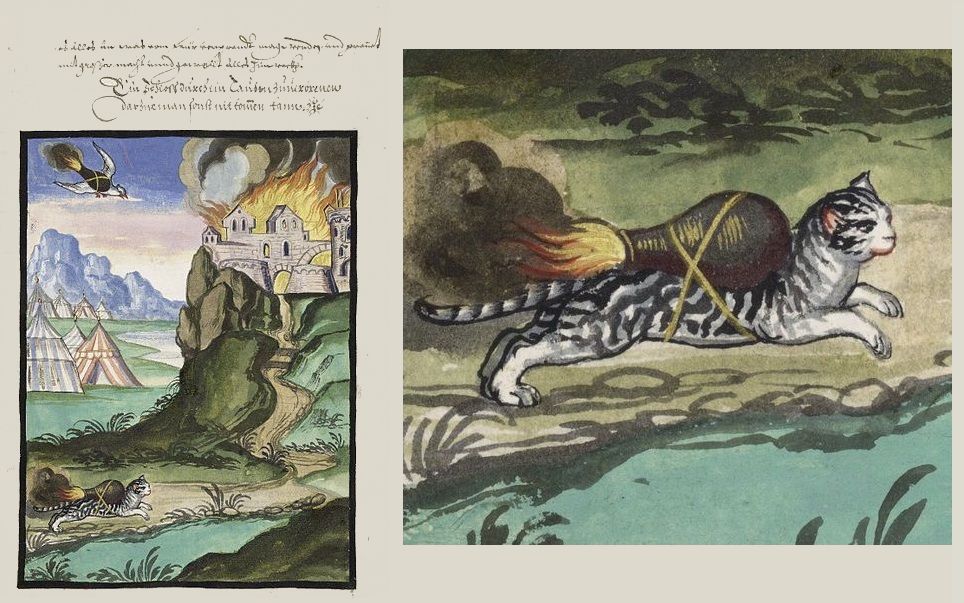
Egyptians Loose Flaming Felines (Corsicana Daily, 16th November, 1951): The newspaper Al Ahram reported today that Egyptian underground commandos sent flaming cats racing through a British airport in the Suez Canal Zone to touch off fires in several shops. The paper said the “Ismallia Commandos” wrapped number of live cats in oil-soaked rags, ignited them and turned them loose at the airport. While the blazing cats streaked through the shops, the paper said, the Commandos then cut off the water supply. Other Commandos slipped into a hangar and set fire to a plane during the excitement. At this point, the paper said, the Commandos fired at the British soldiers on the field with tommy-guns and then withdrew. A British military spokesman said he was investigating the report.
POISON GAS EXPERIMENT - The Winnipeg tribune, 17th May, 1946
German Cats Flown To Britain For Test
Cats were smuggled out of Germany and shipped to England shortly after the outbreak of war just to prove an experiment in poison gas. This story of daring British efficiency was recalled in an interview by Lt.-Col. Athol R. Gordon, now returned to his medical practice in Winnipeg after more than six years overseas with the R.C.A.M.C.
"German cats were wanted for experimental purposes because there was a report that German phosgene RAS was more lethal than ours," recalled Col. Gordon, at one time in command of chemical warfare laboratories of the Canadian Army in England. "The physiologists wanted to be sure that the German cat, upon which the German experts based their claim, was of the same resistance and calibre as our cats,” explained Col. Gordon. "The conditions of two experiments must be similar before an assessment of the potency of an agent can be made.”
German cats were duly collected by intelligence agents, taken back to England the same night by plane, and exposed to English phosgene. The British expert came out with this cryptic conclusion: "The German cat is a poor thing.”
